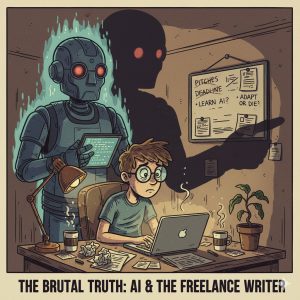
I’ve been watching this unfold from an interesting vantage point—as a 77-year-old author experimenting with AI collaboration while also paying attention to what’s happening to working writers trying to make a living. And I’ve got to tell you, if you’re thinking about becoming a freelance writer in late 2025 to pay the bills, you need to understand what you’re walking into.
It may not be as bad as Ahab thinking he could defeat Moby Dick, but it’s close…
Let me start with something that might surprise you coming from someone who’s been collaborating with AI on documentary fiction projects since early 2025: freelance writing as we knew it is getting hammered right now, and AI is holding the sledgehammer.
This isn’t going to be one of those “everything’s fine, just adapt!” pieces. I’m going to give you the unvarnished truth about what’s actually happening out there, based on real data and real writers’ experiences.
Buckle up. It’s not pretty.
The Numbers Don’t Lie (And They’re Depressing)
Companies that initially relied on AI-generated content soon realized it hurt their SEO rankings, with Google and other search engines prioritizing high-quality, human-written content over AI-generated material. That should be good news for human writers, right?
Wrong.
Here’s the catch: Many businesses still expect cheap content because they got used to paying pennies for AI-generated articles and now hesitate to pay writers what they’re worth.
Think about what that means. AI briefly crashed the market by flooding it with cheap content. Then businesses realized that cheap content was hurting them. But instead of returning to reasonable rates for quality human writing, they’re stuck in this weird middle zone where they want human quality at AI prices.
Freelancers report a noticeable decline in available writing opportunities, especially for entry-level and general content creators. And here’s the kicker: entry-level roles that used to be the backbone for new freelancers—think $40 blog posts, listicles, and other basic assignments—are now being handed off to AI almost entirely.
The ladder that used to let new writers climb into the profession? AI just removed the bottom three rungs.
But Wait—There’s a Plot Twist
Right when I was ready to write the obituary for freelance writing, something interesting started happening in 2025.
A report from the University of Copenhagen studying 25,000 workers across 7,000 workplaces found that the impact of AI was underwhelming—most saw just a 3% time savings, and only a tiny portion led to noticeable income growth of around 3 to 7%.
Translation: The AI efficiency revolution was oversold. Companies are discovering that ChatGPT can’t actually replace skilled writers, at least not without creating other problems.
And here’s where it gets really interesting: One client explicitly stated they wanted original SME (subject matter expert) content with no AI to be used, while others wanted content where writers can share their experiences.
The AI bubble, it seems, has finally burst. Or at least deflated significantly.
Freelance writing coach Elna Cain reports getting more client inquiries in 2025 than she saw in all of 2024, and she’s hearing similar success stories from other freelance writers. Companies are discovering that AI tools aren’t saving them time or money in the long run—they’re having to rewrite or severely edit AI-generated content anyway.
So there’s good news buried in the bad news. But you need to understand exactly what this means for your prospects.
Who’s Actually Surviving (And How)
Not all freelance writers are struggling equally. The data shows a clear pattern about who’s making it and who’s drowning.
On average, freelance writers earn around $42,000 per year, with 24% earning more than $50,000 annually. But that average conceals massive variation based on specialization.
Writers who focus on technical, legal, medical, or finance niches are in high demand. These are the specialized areas where AI can’t fake expertise convincingly.
Let me give you some specific numbers about what actually pays in 2025:
The High-Paying Niches:
White paper writing commands rates of $6,000 per month or more. These are typically for B2B markets where expertise matters.
Video script writing pays $200 to $500 per scripted minute, with high demand for SaaS product demos and YouTube videos.
Ghostwriting rates begin at around $3,000 per month, with book ghostwriting starting at much higher rates for established writers.
According to Payscale, freelance writers in the US earn an average of $27.25 per hour, though this varies dramatically by niche.
The pattern is clear: specialized knowledge that AI can’t replicate commands premium rates. Generic content writing? That’s where the bloodbath is happening.
The Specialization Imperative
Here’s what successful freelance writers are doing differently in 2025: they’re niching down hard.
The top three niches from recent surveys are digital marketing, SaaS (Software as a Service), and eCommerce—all high-paying niches.
But it’s not just about picking a profitable niche. It’s about having genuine expertise that makes you valuable.
Despite fears of replacement, there’s actually a skills shortage emerging, with 55% of leaders concerned about having enough talent to fill roles, jumping to 60% or higher for those in cybersecurity, engineering, and creative design.
Think about that. We’re simultaneously experiencing:
- Fewer opportunities for general content writing
- A shortage of specialized technical writers
- Companies desperately seeking writers who actually understand their industry
The writers who are thriving understand this reality. For entry-level writers, offering AI-editing services is becoming a viable path—many companies need skilled editors to refine AI-generated drafts.
The New Roles AI Is Creating
Here’s something I didn’t expect: AI is creating entirely new writing roles, even as it eliminates others.
The AI content writer role is emerging as a mix where humans guide, prompt, and refine AI-generated drafts to fit a brand’s voice and goals. These professionals aren’t writing from scratch—they’re crafting machine-generated content into something ready to publish.
AI content proofreaders are in demand to spot AI “tells,” correct awkward phrasing, verify facts, and maintain consistency. Since AI can produce errors or bland content, these proofreaders keep content credible and engaging.
These aren’t the writing jobs we imagined five years ago. But they’re real jobs, with real paychecks, for writers who can adapt.
What Actually Works Right Now
Based on the data and reports from working writers, here’s what’s actually generating income in late 2025:
1. Deep Specialization
Seventy-seven percent of content most freelance writers create are blog posts, which makes sense given that content marketing will be worth more than $600 billion by 2024. But not all blog posts are created equal.
The writers earning good money are creating long-form, specialized content that requires genuine expertise. Video script writing rates range from $0.30 to $0.70 per word, but only if you understand the format and can deliver scripts that actually work.
2. Hybrid Skills
Writers who embrace AI as a tool rather than a threat are finding new ways to stay relevant and grow. The key is using AI to enhance your productivity while maintaining the human elements that make content valuable.
3. Building Personal Brands
Clients trust recognizable names—developing a portfolio, staying active on LinkedIn, or starting a newsletter platform like Substack helps writers stand out.
4. Understanding the Full Marketing Funnel
Content strategy remains human-led—writers need to understand SEO basics, content planning, and reader intent. It’s not enough to write well anymore; you need to understand why businesses need content and how it fits into their larger strategy.
The Uncomfortable Truth About Income

Let me hit you with some reality about what freelance writers actually earn.
Lifestyle writer Jessica Clark, writing for 10 years, currently charges $0.07 per word (about $105 per 1500-word article) and is on track to make $24,000 this year.
Meanwhile, more experienced freelance writers like Ashley Cummings charge $1 per word. That’s the difference between $105 and $1,500 for the same length article.
What’s the difference? Specialization, expertise, and the ability to demonstrate value that goes beyond word count.
According to research by We Are Indy, beginners typically start at lower per-word rates, while experienced writers with specialized knowledge command significantly higher fees.
The income gap between generalist writers and specialized experts has never been wider, and AI is making that gap even more pronounced.
No Time for BS
Look, I’m going to level with you because I’m 77 years old and I don’t have time for bullshit.
If you’re thinking about becoming a freelance writer in late 2025 to make quick money, don’t. The entry-level market is brutal right now. Entry-level roles that used to serve as stepping stones for new freelancers are now being handled by AI.
But if you have genuine expertise in a specialized field—if you actually know something that AI can’t fake—there are opportunities. Advanced technologies like artificial intelligence, machine learning, and cybersecurity require specialized technical writers.
The key is understanding that freelance writing in 2025 isn’t about being a good writer. It’s about being a writer who knows something valuable that AI doesn’t.
What You Should Actually Do
If you’re serious about freelance writing despite everything I’ve just told you, here’s my advice:
Don’t try to compete on price. The race to the bottom has no winners, only survivors who hate their lives.
Pick a specialized niche you actually know something about. Your day job, your hobbies, your education—mine whatever knowledge you’ve accumulated that AI can’t replicate.
Learn to work with AI, not against it. AI can help with ideation, outlining, editing, marketing, and productivity tasks. Use these tools to enhance your efficiency, not replace your expertise.
Build a portfolio that demonstrates specialized knowledge. Generic blog posts won’t cut it anymore. Show that you understand your niche deeply enough to add value beyond what AI can provide.
Network obsessively. Understanding industry trends and connecting with potential clients through professional associations helps writers stay informed.
In my next post, I’ll get more specific about the practical steps you can take to actually land freelance writing work in 2025—the pitching strategies, the portfolio building, the niche selection process. Because knowing the brutal truth is only half the battle.
The other half is figuring out how to fight anyway.
Hey, I’m 77 and I’ve Got Stories…
Stories about what it’s like to navigate life at this age (spoiler: it’s weird, wonderful, and occasionally terrifying). And stories about collaborating with AI to write books in ways that would have seemed like science fiction when I started putting words on paper. Stories about the daily realities, unexpected surprises, and hard-won wisdom that comes from three-quarters of a century on this planet. If you’re curious about authentic aging, writing innovation, or just enjoy good storytelling from someone who’s been around the block, subscribe to my weekly newsletter “Old Man Still Got Stories.” I promise to make it worth your time.